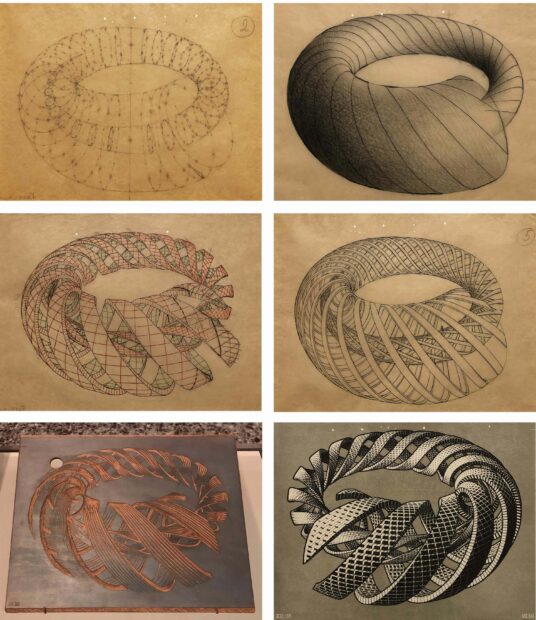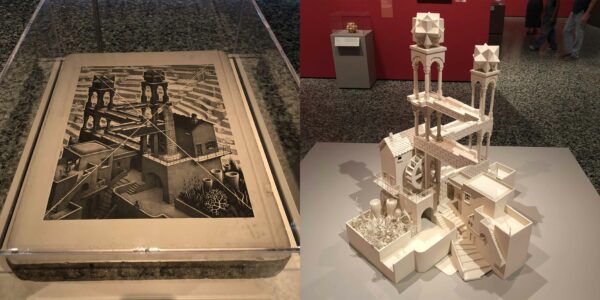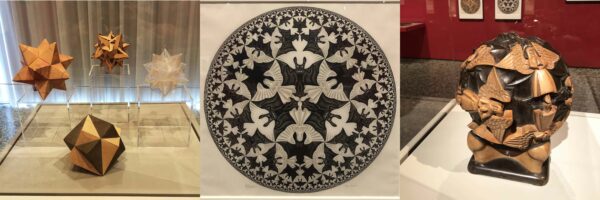
M.C. Escher, (With Jette Umiker Escher), “Study of Majolica Tiles, at the Alhambra, Granada, Spain,” 1936, colored pencil, watercolor, ink and graphite on graph paper
“I kinda want to see the Escher show,” I whispered to a friend when he asked what I wanted to do on a recent trip to Houston. M.C. Escher is one of those artists who falls outside the cannon of modern art. While he was making work during the golden years of Modernism in Europe and America, he seemed to be out of touch with the major trends of the 20th century. He is sometimes described as a “one-man art movement.” Conceptually, his work is not too far from Surrealism, as it often explored cerebral themes. However, he lived a life too far away from the avant-garde of Paris and other social scenes to be included in any of the movements of the early 20th century. This was precisely the reason for my timid tone when talking about his show.
Perhaps Escher is excluded in art history books because he didn’t see himself as an artist in the same ways that many modern artists did. Evidently the singer/songwriter Graham Nash called Escher to tell him how much he enjoyed the work, and Escher responded by saying, “I am not an artist, I am a mathematician.” Truth be told, a fair amount of his work could be considered mathematical illustration, which alludes to a rift between fine artists and illustrators, where talented painters like Norman Rockwell, N.C. Wyeth, and Fredrick Remington are looked down upon.
M.C. Escher is clearly a graphic artist known worldwide for his visually complex imagery. His work has decorated many a college dorm room, and has been viewed through a haze of pot smoke and under the influence of hallucinogens by millions. Don’t judge me, but I used to be a hippie — at least the 90s version of one — and personally have owned no fewer than three M.C. Esher t-shirts. This psychedelic commercialism may detract from Escher’s legacy, but the man himself admitted to not liking San Francisco hippies because they were stealing his design and making money from them.

M.C. Escher, “Eye,” October 1946, Mezzotint with drypoint on wove paper, state VII/VII edition #1; “Eye,” October 1946, Mezzotint with drypoint on wove paper, proofs I-VI/VII
Despite all the detracting factors to his artistic legacy, M.C. Escher is an artistic force to be dealt with, and the exhibition Virtual Realities: The Art of M.C. Escher from the Michael S. Sachs Collection at the Museum of Fine Arts, Houston does an effective job of proving this point. The show is expansive, with over 400 objects, and while it does play to some of the aforementioned commercialism by including black light posters, album covers, and Escher cover art, curator Dena Woodhall also included a considerable amount of ephemera surrounding his most popular pieces. The exhibition could teach even the most skeptical critics of Escher why his work is important.
While the artist is best known for his prints, and for the fact that he explored several print processes, including lithography and mezzotints, his most prominent works are wood cuts. In the hierarchy of printmaking difficulty, mezzotint sits at the top because it is extremely labor intensive. A form of intaglio, it involves a rigorous process of rocking a plate to get rich blacks, then burnishing areas back to get a full spectrum of mid-tones. To demonstrate this challenging process and Escher’s dedication to perfection, six proofs are displayed along with the final version of Eye, a photo-realistic eye with a skull reflected in its pupil. The difficulty is amplified by the in-depth commentary of the process in the audio guide by Liv Monique Johnson, Instructor and Print Studio Manager at the Glassell Studio School at the MFAH. Eye also just so happens to be the work that was featured on one of the t-shirts I owned.

M.C. Escher, Study For “Spirals” (2), c. 1953, graphite on tracing paper; Study For “Spirals” (5), c. 1953, ink on tracing paper; Study For “Spirals,” c. 1953 red, black and green ink on wove paper; Study For “Spirals,” c. 1953, graphite and ink on tracing paper; “Spirals,” c. 1953, woodblock for tone; “Spirals,” December 1953, Wood engraving in black and gray, printed from two blocks on handmade paper
A major strength of the show is this inclusion of Escher’s preliminary sketches, printing plates, and studies alongside the works themselves. To see the amount of planning and preparation that goes into the pieces is as impressive as realizing that Escher had to execute most final designs in reverse, meaning he had to invert the marks as negative space when transferring them to a print plate.
One work, Spirals, is accompanied by four preliminary sketches along with one of the woodblocks used to print the design. The image is a torus made of spiraling bands, based on an illustration from Daniele Barbaro’s La Practice della Perspectiva, which Escher was unimpressed with and spent months improving upon. Escher’s craftsmanship is undeniable, but it was built upon through years of practice.
To highlight Esher’s printmaking prowess, the first two rooms of the exhibition are filled with landscape prints he made while touring southern Europe. After this time, he lived in Italy from 1923 to 1935. While these pieces are not as well known as his late career works, they show an artist at the beginning stages of developing a mastery of print design, and of rendering expansive landscapes and architecture. I still use Escher’s work to teach my own print students how to render grayscale without gradients in order to create the illusion of depth.

M.C. Escher, “Infant (Arthur E. Escher),” February 1929, Woodcut in red-brown and pink, printed from 3 blocks on handmade paper
Even with a mastery of technical skill, Escher’s imagery could appear cold. Commonly devoid of human figures — which are often drawn crudely, if included at all — Escher’s work appears to have little humanity, even when it does. The exhibition, however, offers exceptions, with a few examples of portraiture. A notable work, Infant (Arthur E. Escher), is a portrait of his second son printed in shades of red. The proficiency of the rendering is excellent, but the result just comes off as a creepy baby portrait and illustrates that Escher’s talents lie with other subject matter.
Considering the fact that Escher was in Europe, working and witnessing the horrors of the Second World War, the seeming lack of humanity in his work presents a quandary. The war directly affected Escher, like it did anyone that lived through it. He was forced to leave Italy in 1935 because of the rising tide of fascism, and relocated to the home of his wife in Switzerland, which he hated because of the snow. They then relocated to Belgium until the Nazi’s invaded, and he had to return to Holland, where he was from originally, and which was already under Nazi control. Here, the war hit closest to home.
Earlier in his life, Escher studied under the Dutch graphic artist Samuel Jessurun de Mesquita at the Haarlem School of Architecture and Decorative Arts. Upon his return to Holland in 1944, Escher wished to reconnect with de Mesquita, but when he went to visit the artist’s studio he found it empty and in shambles. De Mesquita, a Jew, had been taken away and would later die at Auschwitz. Legend has it, Escher found a drawing by de Mesquita with a Nazi boot print on it that he kept for the rest of his life. Despite this loss, and while many other artists directly addressed the war and other socio-political issues head on in their work, emotion seems to be almost as absent as the figure in most of Escher’s art. One could read the skull in Eye, made in 1946, as a hint of a socio-political message, and it is likely he found some catharsis from the hours of toiling over the mezzotint process, which he called “the Black Art.” But while the specter of death was heavy in Europe in 1946, Escher was adamant in keeping politics out of his work.

M.C. Escher, “Puddle,” February 1952, woodcut in black, green and brown, 3 blocks on handmade paper, state II/II; “Puddle,” c. 1952, woodcut on wove paper, proof of tone block and puddle block; “Puddle,” c. 1952, woodcut on wove paper, proof of tone block; Puddle Blocks, 1952, (r to l): wood block for tone, wood Block for puddle, wood block for black ink
However, one piece in the show caught me off guard. The work has a smooth gray gradient with a simple circle in the lower corner. Always the fan of Minimalism, I wondered where this serene composition came from, before I realized it was the first layer of the three-color print Puddle. The next two images show the build up ending with the final result of a puddle of water reflecting the night sky. The woodblocks used to make the print sit in a vitrine in front of the sequence of print separations, which could be individual works of art on their own. The edges of the puddle are broken by tire tracks in mud, and boot prints surround the puddle. This print was made in 1952, and one can speculate that the piece was both Escher’s response to finding de Mesquita’s boot-dented drawing, and the result of a decade of coping with the loss of his teacher. Puddle makes a strong case that Escher believed art exists above the mud and mess of this world.
On the front end of the war, Escher was able to visit the Alhambra in Granada, Spain for a second time and before it also descended into fascism. On his original trip in 1922 he found the tessellated tiles covering the walls appealing, but on his second visit in 1936 the patterns had a different, new impact. With the assistance of his wife, Jetta, he began to make sketches of the tiles.
Tessellations are a way to cover planes with repeating geometric shapes so there are no overlaps or gaps. They are composed of interlocking tiles, and this feature is a prominent factor in my own work; I began to use them because of their calming effect. Many years ago, I was looking through a pattern book when I received a call about an infuriating family situation. As I continued to look at the pages of tessellations, they brought me a palpable peace. I have used these geometric patterns in my paintings and prints to bring comforting order to the chaos found in life ever since, and I would like to believe that Escher and his wife found the same calm looking at the walls of Alhambra, despite the approaching storm clouds of war.
Coincidence or not, Esher does attribute this second experience to a fundamental moment in his future work: the exploration of “mental puzzles.” The show includes several drawings from his time at the Alhambra, the first of which shows an off-center pattern tile. “Busted!” I said to myself, because in this sketch it appears as if Escher didn’t understand the tiling of tessellation yet. However, my sense of superiority quickly evaporated as the next portion of the show demonstrated he did, in fact, truly understand tessellation more than I ever hope to. This section culminates with 15 drawings (made of hundreds) of tessellations where shapes are replaced with animals. This work is the beginning of Escher’s mathematical investigations, or the style that he is best known for. These symmetry drawings, as he called them, represent the Four Types of Symmetry and allude to 17 Wallpaper Groups, both of which are used in art, as well as fields like crystallography, geology, and biology. In fact, Escher corresponded with scientists and mathematicians about many of his late-career works.

M.C. Escher, Symmetry Studies: “Symmetry No. 107 (Fish),” December 1960, ink and watercolor on graph paper; “Symmetry No. 117 (Crabs),” April 1963, colored pencil, ink and watercolor on graph paper; “Symmetry No. 69 (Fish, Duck and Lizards),” March 1948, ink and watercolor on graph paper
I could fill the rest of this article with geometric terminology, but I will prevent the eye-glazing that often occurs when nerding out over math. Instead, I’d prefer to return this review to the tangible world and the hidden humanity of Escher’s work. One of the most exciting things that happened while I was at the show was hearing a father yell while trying to prevent his toddler from playing in a 3D model of the lithograph Waterfalls, arguably one of Escher’s most well-known images of an aqueduct that feeds itself. While the architecture itself is impossible, this sculpture does an excellent job of bringing it to life, as long as it is viewed from the correct angle. The inclusion of sculpture in the show was an intelligent and intriguing aspect — Escher himself designed geometric constructions that would make amazing contemporary public sculptures if enlarged. Another piece, Heaven and Hell Sphere, a 3D wooden carving of interlocking angels and devils, is based on Escher’s 2D symmetry studies. Both represent his attempt to render infinity.

M.C. Escher, “Waterfall,” 1961, lithographic stone; Bruce Winkler, After M.C. Escher, 3D model based on the lithograph Waterfall, painted wood
I attended this show the week before flying to Mexico City to begin a residency at Tajo Taller, and the timing could not have been more perfect. At Tajo, I worked with a CnC machine and 3D printers, and seeing Escher’s work was invaluable to illustrate the methods of expanding my own tessellations into the third dimension. The use of these new technologies also represents the fusion of science, math, and technology, and during my time in Mexico, I had to reteach myself trigonometry to get accurate 3D models of my designs. I also found myself embroiled in battle with a Drawbot, a device found in many STEAM labs. Drawbots are simple robots designed to hold a pen, and they’re rife with limitations, which I found to be a unique foil to my design process; they produced results I would have not gotten any other way. This process of integrating the tool into the work reminded me of Escher trying to figure out how to render his expansive landscapes and forced-perspective architectures using the single tone allotted to his early series of prints.

M.C. Escher, “Three Stellated Dodecahedrons,” c. 1952, transparent plastic, paper and wood; “Two Interlocking Cubes,” c. 1952, paper; “Circle Limit IV,” July 1960, woodcut in black and ochre, printed from two blocks, on handmade paper; “Heaven and Hell Sphere,” 1942, maple wood, stained in two colors
Escher’s art is a problem-solving process, and this concept plays out into the work of art history mainstays like Bridget Riley, Victor Vaserely, Josef Albers, Sol Le Witt, and even Houston’s hometown hero, Suzie Rosmarin. Sequentiality and experimentation are the threads that tie these artists together. Escher may not be included in the abstract or conceptual cannon because of his use of representational imagery, but his images have the unique ability to connect with the general public.
At the MFAH, I found myself perusing the show behind a grandfather talking to his grandson about the work. He would discuss the imagery, then expound on the mathematics behind the works. The child was young enough for this to be a core experience, and I could not help thinking how these intimate lessons would expand and shape his future. I can now see how my stoner t-shirts and trippy posters of Escher’s work fed into my own growth as an artist, from my discovery and implementation of tessellations to the inspiration that became central to my time at my recent residency.
Escher’s work is a foundation on which we build structures to understand art, math, science, life and the universe. Whether we like it or not, his work can be expanded on in innumerable combinations, and in that way he was successful in capturing infinity. Virtual Realities at the Museum of Fine Arts, Houston does Escher’s work justice by presenting his career in full periphery. Now, I can say with confidence, “I saw the Escher show!”
Virtual Realities: The Art of M.C. Escher from the Michael S. Sachs Collection is on view at the Museum of Fine Arts, Houston through September 5, 2022. For additional reading on Escher’s work, see the 1992 book M.C. Escher: His Life and Complete Graphic Work, or listen to Stuff You Should Know’s episode about the artist.



2 comments
This is a fantastic show, and yes: that was a surprise to me too. Kudos to curator Dena Woodall for putting this and the Shahzia Sikander shows together at MFAH this year. A strong double header from MFAH prints and drawings, consistently one of my favorite galleries in the Kinder building.
Well, Rainey said it all! Dena is kicking it.